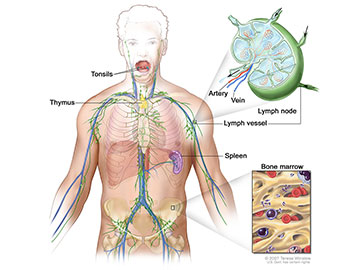Non-Hodgkins lymphoma Research Areas Involving NZ Researchers:
Non-Hodgkins lymphoma and Behavioural Research
Associate Professor Andrea ‘t Mannetje,
Non-Hodgkins lymphoma Biology
Non-Hodgkins lymphoma Screening and Epidemiology
Associate Professor Brian Cox, Dr Mary-Jane Sneyd,
Standards of Service Provision for Non-Hodgkins lymphoma Patients in New Zealand – Provisional
This provisional Non-Hodgkins lymphoma tumour standard describes the level of service that a person with bowel cancer in New Zealand should have access to. All of the recently developed provisional tumour standards include a number of standard statements that are generic across most cancers; they apply to all people with cancer and to all cancer types.
Recent International Non-Hodgkins lymphoma Research
Overview
Lymphoma is cancer that begins in cells of the lymph system. The lymph system is part of the immune system, which helps the body fight infection and disease. Because lymph tissue is found all through the body, lymphoma can begin almost anywhere.
The two main types of lymphoma are Hodgkin lymphoma and non-Hodgkin lymphoma (NHL). These can occur in both children and adults.
Most people with Hodgkin lymphoma have the classic type. With this type, there are large, abnormal lymphocytes (a type of white blood cell) in the lymph nodes called Reed-Sternberg cells. Hodgkin lymphoma can usually be cured.
There are many different types of NHL that form from different types of white blood cells (B-cells, T-cells, NK cells). Most types of NHL form from B-cells. NHL may be indolent (slow-growing) or aggressive (fast-growing). The most common types of NHL in adults are diffuse large B-cell lymphoma, which is usually aggressive, and follicular lymphoma, which is usually indolent.
Mycosis fungoides and the Sézary syndrome are types of NHL that start in white blood cells in the skin. Primary central nervous system lymphoma is a rare type of NHL that starts in white blood cells in the brain, spinal cord, or eye.
The treatment and the chance of a cure depend on the stage and the type of lymphoma.
Anatomy of the lymph system, showing the lymph vessels and lymph organs including lymph nodes, tonsils, thymus, spleen, and bone marrow.
Adult Hodgkin Lymphoma Treatment – Patient Version
Adult Non-Hodgkin Lymphoma Treatment – Patient Version
AIDS-Related Lymphoma Treatment – Patient Version
Mycosis Fungoides (Including Sézary Syndrome) Treatment – Patient Version
Primary CNS Lymphoma Treatment – Patient Version
Childhood Hodgkin Lymphoma Treatment – Patient Version
Childhood Non-Hodgkin Lymphoma Treatment – Patient Version
Adult Hodgkin Lymphoma Treatment – Health Professional Version
Adult Non-Hodgkin Lymphoma Treatment – Health Professional Version
AIDS-Related Lymphoma Treatment – Health Professional Version
Mycosis Fungoides (Including Sézary Syndrome) Treatment – Health Professional Version
Primary CNS Lymphoma Treatment – Health Professional Version
Childhood Hodgkin Lymphoma Treatment – Health Professional Version
Childhood Non-Hodgkin Lymphoma Treatment – Health Professional Version

